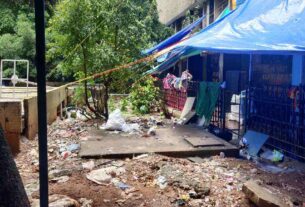Fixed fares at the newly launched pre-fixed auto rickshaw fare booths at metro stations cause problems to the drivers. Passengers affected by fewer autos and technical glitches at the booths.
Auto rickshaw drivers at the pre-fixed auto rickshaw booths at Mahatma Gandhi (MG) Road, Cubbon Park and Nagasandra said they do not prefer the fixed fare system as the fare is not set at right prices. “The technology used to print the travel slip at a pre-paid auto stand does not calculate most factors that may result in a change in the distance,” they added.
Arif, an auto driver, a regular at MG Road said the machine on which the prices were fixed does not take into consideration one-way roades and other problems and calculated the fare solely based on kilometres. He said, “The distance between M.G Road to Garuda mall is around one kilometre and the fixed meter shows Rs.30. But autos are not allowed on the other side of M.G Road. We have to take a different route which is around two and a half kilometres and the fare would actually cost Rs. 40 to 43.”
Harish (name changed), a regular at both M.G Road and Cubbon Park stations, said the printed slip generated from the machine calculates the fares according to the exact location but the passengers always prefer to be dropped a little further from the location printed and calculated.
The auto fares were fixed by Karnataka Government in November 2021 at Rs.30 for the first two kilometers and Rs.15 for each additional kilometer. From 10 p.m. to 5 a.m. the fare was fixed at1.5 times more than the normal fare. The pre-fixed auto rickshaw fare booths service started on January 4, 2023 in a joint venture between Bangalore Traffic Police (BTP) and Bangalore Metro Rail Corporation Limited (BMRCL), as an attempt to offer first to last-mile connectivity from metro stations.

The machine that generates the slip for passengers, with details of the trip, uses Google maps to detect the location which one wants to travel to. Once the location is confirmed it shows the amount as per the fixed kilometer rates. Next, the auto number is entered into the machine and the machine prints a copy of the same with the auto number, destination, distance and the fare. This small piece of paper is then given to the passenger and the auto rickshaw has to drop the passenger to the same location as in the copy.
Jhon (name changed), a regular auto driver at M.G Road, said, “If I drop a passenger to nearby locations like St. Marks Road or Lavelle Road, it is unlikely for me to get another passenger who will need to be dropped back at M.G Road. I will have to return empty for around one or one and a half kilometers and that is very costly for me as fuel is expensive.” He added, “The initiative is a good one. But if they want to offer first to last-mile connectivity then autos need to be standing outside the station. For that, we need fair rates fixed by the government.”
According to the data provided by the company who provides the technology for BMRCL to operate these booths, around 3,355 passengers had availed the service and 2,808 trips had been covered from all the three stations as of January 17, 2023.
The data shows that at each station, an auto rickshaw on an average made 66 trips each day between January 4 and January 17 that is 14 days since the service was made available.
Pradeep, chief architect of the company, said, “The service is proving to be successful and people are preferring it over ride-hailing apps because the authorities or the booths charge no commission. The prices are fixed according to the government rules, we do not profit from it. In fact, it is like a service for the people and one of the responsibilities of the authorities to offer connectivity.”
Data shows that most number of passengers availing fare booth services were from Cubbon Park station to Mount Carmel College (MCC), Cunningham Road, Palace Road, Lavelle Road and from M.G Road, the most preferred drop stations were Commercial Street, Shivajinagar, Bishop Cotton school, Richmond Road, and other nearby places where people travel daily in large numbers.
“Before the pre-fixed auto booths they would charge Rs.20 each person and take around four or five of us together. But after the booths have been set up many auto rickshaws do not stand around the metro stations as the price is fixed and only three people per auto are allowed and we have to wait long hours to reach college. As a person who travels regularly from Cubbon Park metro station, I see no change, only fewer autos,” said Anna Rose, a student of MCC.

One of the passengers at M.G Road station, who tried to avail the service, was not able to enter her preferred location, Hombegowda Nagar, as it was not detected on the machine. When she tried to take an auto normally, auto rickshaws said that they would charge her Rs. 250. She then used one of the ride-hailing apps and the cost was around Rs.110.
Prof. M. N. Sreehari, mobility and transport expert, said, “If auto stands do not want to be part of such an initiative, then they should not stand in the lines where the pre-fixed system is operating. This initiative is to help the passengers for first to last-mile connectivity and the BMRCL cannot ensure that they will cover the cost for autos to get back to the auto stands.”
The expert added, “This scheme is in its initial stages and people should adjust to this. Drivers should also co-operate. And if such a system is not workable for them then they need not participate in this service.”
Pradeep said that new pre-fixed auto fare booths are going to come up in the next week of January at Bayapanhalli, Banashankri and Konanakunte metro stations.
BMRCL official said that it was too early to comment on the booths as it is in the initial stages and was not available for further comment.





The article from Ms. Dipali, is well documented as she broughtout the real scenario of pros and cons if such a system come into effect. This prepaid system is followed throughout the world for a total integrated transportation system connectivity and Autos are also a part of this system and to be included as feeder service to establish first and last mile connectivity. Any shortfall and issues to be sorted out involving them as a part of the system.